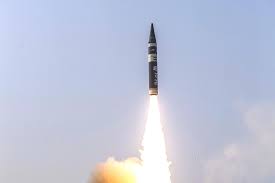In a significant boost to its strategic weaponry, India has successfully test-fired a new generation nuclear capable ballistic missile, ‘Agni Prime’. The launch took place at night from the Abdul Kalam Island off the Odisha coast, marking a crucial advancement in the nation’s military capabilities.
This was the first pre-induction night launch of the missile, which boasts a strike range of 1,000 to 2,000 km. The Defence Research and Development Organisation (DRDO) and the elite Strategic Forces Command conducted the operation on Wednesday.
The Defence Ministry has confirmed that the test-firing met all desired objectives, which paves the way for the system’s induction into the armed forces. The accomplishment comes amidst an ongoing border row with China, thereby strengthening India’s defence preparedness. In a statement, the ministry detailed the successful flight-test of the ‘Agni Prime’, carried out by the DRDO from Dr APJ Abdul Kalam Island. This launch followed three successful developmental trials, showcasing the system’s accuracy and reliability. Defence Minister Rajnath Singh lauded the DRDO and armed forces for the successful launch and stellar performance of the new generation ballistic missile. Range instrumentation tools like radar, telemetry, and electro-optical tracking systems deployed at various locations collected flight data across the entire trajectory of the vehicle. DRDO Chairman, Samir V Kamat, acknowledged the dedication and hard work of the DRDO teams and users involved in the test launch. This missile launch follows a series of successful tests, including the Agni-V in December, capable of hitting targets up to 5,000 km, covering nearly the entirety of Asia, parts of China, and regions in Europe. The previous Agni series, from 1 to 4, with ranges between 700 km to 3,500 km, are already deployed. In April, India tested an endo-atmospheric interceptor missile from a ship off the Odisha coast in the Bay of Bengal, showcasing its ability to intercept hostile ballistic missiles. This is a significant step towards India’s development of capabilities to counter missile threats both inside and outside the earth’s atmospheric limits.

















